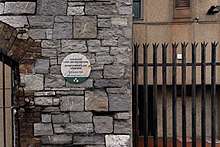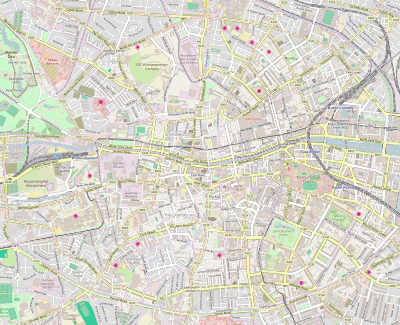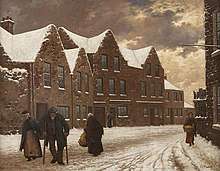Marrowbone Lane
Marrowbone Lane (Irish: Lána Mhuire Mhaith) is a street off Cork Street in Dublin, Ireland.
 Sign commemorating the Marrowbone Lane Garrison of 1916 | |
 | |
| Native name | Lána Mhuire Mhaith (Irish) |
|---|---|
| Part of | The Liberties |
| Namesake | Marylebone |
| Length | 700 m (2,300 ft) |
| Width | variable, up to 20 metres (66 ft) |
| Location | Dublin, Ireland |
| Postal code | D08 |
| Coordinates | 53.339949°N 6.285764°W |
| north end | Thomas Court, School Street, Earl Street South |
| south end | Cork Street |
| Other | |
| Known for | distillery, infirmary, Easter Rising |
The street is known for the fierce fighting that took place on it during the Easter Rising of 1916. The distillery on this street was used as a strongpoint by a force of more than a hundred rebels under the command of Eamonn Ceannt, which also held the nearby South Dublin Union.[1] Ceannt was executed by the British authorities after the rising's failure. His second-in-command was Cathal Brugha, and other participants who achieved later prominence in one way or another were W. T. Cosgrave, Joseph McGrath and Denis O'Brien.[2]
In describing the careers of participants, the terms "fought at Marrowbone Lane" and "fought at the South Dublin Union" are used interchangeably.

In 1939, Robert Collis wrote the play Marrowbone Lane.
Name
The lane is named after Marylebone in London; Pimlico is located right next to it, and other London-inspired street names are nearby, like Spitalfields. These were brought to Dublin by London wool-workers, who settled in the area after William III's conquest of Ireland in 1690.[3][4] Marylebone, London, commonly pronounced like "Marrow-bone", is named after the church of St Mary at the Bourne, later corrupted to "Mary le Bone", Middle French for "Mary the Good." The Irish street name reproduces this error, literally meaning "Lane of Mary the Good."[5] By 1743, the street name was corrupted to Marrowbone Lane.[6]
References
- Boylan, Henry (1998). A Dictionary of Irish Biography, 3rd Edition. Dublin: Gill and MacMillan. p. 63. ISBN 0-7171-2945-4.
- Ryan, Desmond (1966). The Rising (4th Edition). Dublin: Golden Eagle Books. pp. 172–184.
- Johnston, Máirín (November 30, 1985). "Around the banks of Pimlico". Attic Press – via Google Books.
- Martin-McAuliffe, Samantha L. (September 22, 2016). "Food and Architecture: At The Table". Bloomsbury Publishing – via Google Books.
-
Smith, Thomas (1833). A Topographical and Historical Account of the Parish of St. Mary-le-Bone. London: John Smith. pp. 3.
st mary at the bourne.
- Bardon, Carol and Jonathan (1988). If Ever You Go to Dublin Town. Belfast: The Blackstaff Press. p. 63. ISBN 0-85640-397-0.